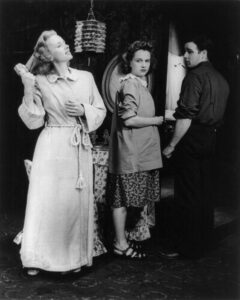Actors have secrets to share with writers

I studied acting in Los Angeles in my early twenties and I went on to found and serve for five years as creative director of a nonprofit theater. One of my primary motivations was to learn about conflict, pacing and dialogue as actors embodied the words in my plays and the work of other playwrights. At the acting studio where I studied, the teacher drew techniques from the system developed by Konstantin Stanislavsky (also spelled Stanislavski) that gained prominence in America in the 1930s, known as “the method.” The method technique in a nutshell: the actor aims to bring emotional identification to the character she or he is playing with the goal of conveying psychological/emotional truth. Think of actors Dustin Hoffman and Lee Strasberg and Marlon Brando–“Stella!”
This post shares one of Stanislavsky’s techniques as detailed in his classic book Building a Character and suggests ways it can be used by writers: Personalizing.
Personalizing
Personalizing is the process of working on character from the inside out. A person’s core truths and deepest values define how she views the world and also drive her desires and actions. Method actors grow character traits from those core values rather than simply tacking on mannerisms. Writers use personalizing, too. It’s a process of discovery. Like actors, one of our jobs is to be a student of human nature.

Put us in a train station, an airport, a waiting room–we watch what people do and eavesdrop on what they say and find ourselves connecting our observations to imagined core beliefs to convey emotional truths. What if…? One of the best ways to become familiar with this technique is to personalize yourself!
Make a list of some of your observable traits. For example, when you meet someone new at a party do you make eye contact or do you cast your eyes downward? Is your normal walk a stride or do you shuffle a bit? When you make a mistake do you apologize or do you go on the offensive? When you meet friends for drinks, do you grab a seat at the bar or take a table and sit with your back to the wall so you can assess the room?
Jot down several of your core beliefs. Do you believe the world rewards people who work hard? Or do you believe society rewards privilege over hard work? Do you believe most people are basically good? Or do you believe in the “Sheep, Wolf, or Sheepdog” theory? Do you believe a higher power is watching over you? Or are you agnostic? An atheist? Take your time because your list will grow.
Link one or more of your traits to one of your core beliefs. For instance, if you believe the world is divided between Sheep (innocents and followers), Wolves (predators who prey on sheep), and Sheepdogs (those who must protect the sheep from the wolves) then you might choose that corner table, keep your back to the wall and stay constantly vigilant as you assess the room. Although that’s a heavy-handed example, you get the idea.
Delve deeper. You’ve linked one of your traits to one of your core beliefs. Now delve deeper into your own character and come up with a formative experience or situation that connects to a core belief that links to a trait. If we stick with the “Sheep, Wolf, Sheepdog” example, perhaps you were raised in a military family or you were a foster child or you were raised in a cult–many situations could instill you with a hierarchical view of the world made up of prey, predator, and protector.

You might have been told, Kid, it’s survival of the fittest! In contrast, you might have been imbued with a sense of duty: the strong protect the weak. Maybe you were bullied or you saw someone bullied, abused or neglected. Early experiences are formative–in life and in fiction.
Now that you’ve spent a bit of time exploring your own beliefs and traits, try studying a family member, friend, or lover. Another trick: study an interesting public personality. This is when you get to play the game, What if…?
What if your friend’s brother blinks repeatedly when he’s stressed…and what if he works in a high-pressure job where he needs to maintain the appearance of authority, strength, and control? And what if he wears very dark sunglasses, even on cloudy days? And what if he witnessed his father’s alcoholic binges when he was a kid? And what if he saw things he wishes he could forget? And what if and what if and what if!
In future posts, I’ll cover more acting techniques that writers can use to have fun creating complex, layered, fascinating characters. Remember, our traits come out of our deep beliefs. which are created by and also fortify our worldview. IOW, it’s a reinforcing loop.
More resources: To delve deep into techniques method actors can teach writers, see Brandilyn Collins’ book Getting into Character. And have fun!
We invite you to share your tips, questions, conundrums for creating complex characters–so please feel free to comment and we will respond.




